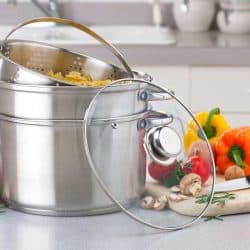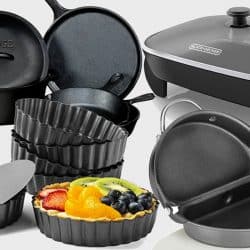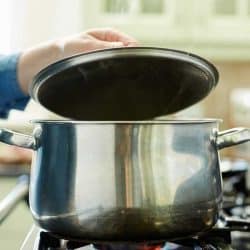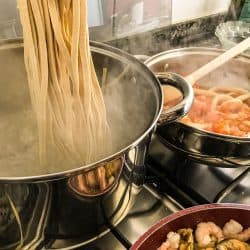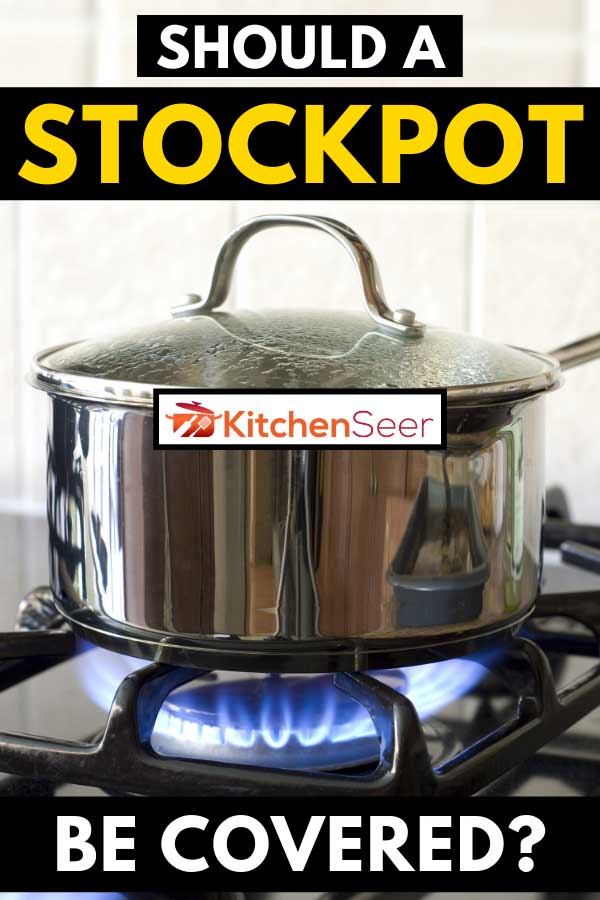 Cooking is a bit of science and a bit of art combined. There are specific rules to follow and others to break when, for example, steaming or simmering your favorite cuisine. When it comes to cooking with a stockpot, there is some confusion about whether the vessel should be covered. Should a stockpot be covered?
Cooking is a bit of science and a bit of art combined. There are specific rules to follow and others to break when, for example, steaming or simmering your favorite cuisine. When it comes to cooking with a stockpot, there is some confusion about whether the vessel should be covered. Should a stockpot be covered?
When cooking with a stockpot, using the cover is optional. The cover or lid is necessary for a cooking method like steaming but not necessarily for simmering. The use of a cover depends on your recipe or your cooking approach.
There are a lot of variables that determine if a lid is needed. Keep reading this post as we explain in more detail when you should use a cover on your pot or not.
Why Put A Lid On A Pot?
When you cover your food with a lid, you trap more heat. If you are trying to retain heat, cover your pot. And if you need to maintain a hot temperature and moisture in your dish, keep a lid on it. On the other hand, if you are trying to thicken a sauce or get a crispy skin, you might want some of that moisture to evaporate. In this scenario, skip the cover and let the vapor escape.
Let's look at different cooking methods to determine if your best bet is to keep the lid on or leave it off.
Steaming: Keep the Cover On
Gentle and moist heat is necessary to steam foods like vegetables, rice, or fish. Food cooked this way will be tender and won't dry out.
Boiling: Keep the Cover On
Some foods like pasta need a rolling boil of water to cook. Other foods might need to reach a boiling temperature before reducing the heat. You'll reach the boiling state faster by trapping the heat with a lid on your pot.
Braising: Keep the Cover On
Some cuts of meat are tougher than others. Braising short ribs, for example, will tenderize meat until it's falling off the bone. A long steady moist heat is required to break down meat to a fork-tender state. A pot with a lid on is the best method for trapping hotness and moisture.
Simmering: Keep the Cover On or Off
The quickest way to reach a simmer is to heat your pot to a boil. The fastest way to boil is to leave a lid on your pot. Once you reach a boil, reduce heat by removing the cover and turning down the heat.
Now, you might want to reduce the heat but leave the lid on if you're trying to lock in flavors and your soup or sauce is at the right consistency. The cover will prevent liquid from evaporating. On the other hand, you might want a sauce to thicken. In this situation, remove the lid and let moisture slowly evaporate.
Searing: Keep the Cover Off
To get a caramelized crust on a protein like beef, you need a hot pan and a dry heat. Moisture will prevent a crispy coating, so leave the lid off the pot.
Stir-Frying: Keep the Cover Off
Foods like chicken or broccoli that you plan to stir-fry will give off moisture when they are heated. Steam should be allowed to evaporate so that you get crispy vegetables and meats in your stir-fry.
Deep Frying: Keep the Cover Off
Hot oil is required to get a crunchy crust on fried food. Leaving the lid on during frying creates moisture that will drip from the lid back into the oil. When water and oil meet, the liquids will pop and splatter.
How Do You Cover A Pot Without A Lid?
Perhaps the lid to your pot broke or is merely missing. If you are in a pinch, and cooking a dish that needs a cover, try one of the ideas below.
Cover the pot with a:
- Sheet of foil
- Metal baking pan or sheet pan
- Skillet or frying pan
- Ceramic plate
- Glass bowl or glass baking dish
Where Can You Buy A Lid For Your Stockpot?
Most cookware manufacturers sell replacement lids for their products. To replace a cover, you'll need the model of your pot or at least know the size. You can contact the manufacturer or shop online for a replacement. Here are a few suggestions for covers to buy on Amazon.
Calphalon is a popular brand that sells replacement lids on Amazon.
Click here to see this 10-inch glass cover on Amazon.
Update International offers stainless steel lids in several sizes.
Click here to see this lid on Amazon.
Gourmia offers a universal lid with an extended rim that will fit most pots.
Click here to find this lid on Amazon.
If you enjoy the hunt in shopping, check out your local thrift stores or hit a garage sale and search for stockpot covers. You never know what treasures you might find.
Is It Better To Simmer Covered Or Uncovered?
Simmering with a lid on or off depends on what you are cooking. Sometimes it's better to cover your pot, and sometimes it's not. Certain types of food need moist heat, while others only need heat.
If you are trying to reduce the amount of liquid in your sauce or stock, for example, you should simmer uncovered. The liquid will evaporate, and the flavors of your dish will intensify at this low temperature.
If you have the right amount of liquid in your lentil stew or are cooking grains like quinoa, for example, leave the lid in place. Moisture and heat will be locked in, and your dish will not dry out.
Does A Pot Boil Faster Covered Or Uncovered?
A covered pot will boil faster than an uncovered pot. When a container is covered, less liquid escapes, and temperatures climb up. An uncovered pot with a constant temperature will lose vapor but will boil, just a bit slower than the covered container. If you keep your pot covered while trying to achieve a boil, you will save a bit of time and energy.
To Cover Or Not Cover Your Pot
Lids to your stock pots or soup pots probably feel like clutter in your kitchen. But make sure you keep them around. Specific recipes and cooking styles need that lid. At the same time, you might only pull the top out once in a while. But you'll be glad you have a cover for your stockpot when you need one.





